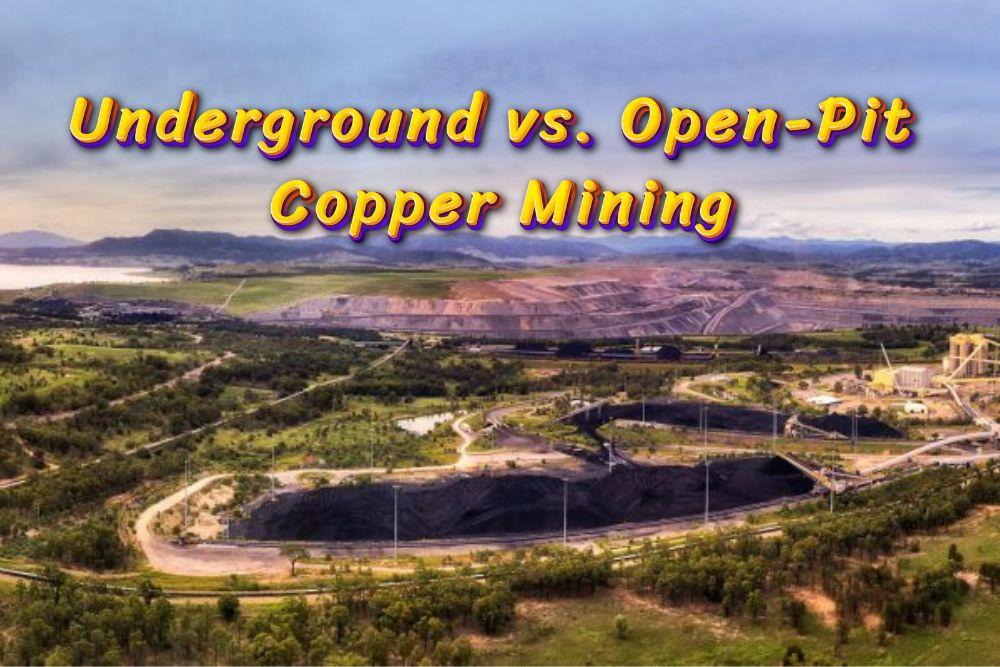Underground vs. Open-Pit Copper Mining: Pros and Cons

Copper is one of the most essential metals in modern industry, used in everything from electrical wiring to renewable energy solutions. But before it reaches manufacturers and consumers, copper must be extracted from the earth through mining. There are two primary methods for mining copper: underground mining and open-pit mining. Each method has its advantages and disadvantages, affecting everything from environmental impact to economic feasibility. In this article, we’ll explore the key differences between these two techniques, helping you understand their benefits and challenges.
What is Open-Pit Copper Mining?
Open-pit mining is the most commonly used method for extracting copper when the ore is located relatively close to the surface. This technique involves removing layers of rock and soil to expose the mineral deposit. Large-scale excavation equipment, such as haul trucks and electric shovels, is used to extract and transport the ore for processing.
Pros of Open-Pit Copper Mining
✅ High Production Rates: Open-pit mining allows for large quantities of copper ore to be extracted efficiently, making it more cost-effective for companies.
✅ Lower Operational Costs: Since the ore is closer to the surface, excavation is less expensive compared to underground mining.
✅ Easier Access to Ore: Open-pit mining provides direct access to large ore deposits without the need for deep tunnelling.
✅ Safer Working Conditions: Because mining occurs at or near the surface, workers are less exposed to risks such as tunnel collapses or underground gas build-ups.
Cons of Open-Pit Copper Mining
❌ Significant Environmental Impact: Large-scale excavation can lead to deforestation, habitat destruction, and air pollution due to dust and emissions.
❌ Visual Pollution: Open-pit mines create massive scars on the landscape that can be seen from miles away, affecting local ecosystems and communities.
❌ Water Contamination Risks: Chemicals used in the extraction process can seep into groundwater, leading to potential water pollution.
❌ Limited Depth: Once the accessible surface ore is depleted, deeper deposits may require switching to underground mining.
What is Underground Copper Mining?
Underground mining is used when copper ore is located deep beneath the surface and cannot be efficiently reached through open-pit methods. This method involves digging tunnels and shafts to access the ore body, which is then extracted using specialized machinery.
Pros of Underground Copper Mining
✅ Less Surface Disruption: Since underground mining does not require large-scale excavation, it has a much smaller impact on the surrounding environment.
✅ Preserves Landscapes: Unlike open pits, underground mines do not drastically alter the natural scenery.
✅ Lower Water and Air Pollution: The contained nature of underground operations helps reduce exposure to pollutants.
✅ Access to Deeper Ore Deposits: Underground mining allows miners to extract copper from deeper levels, making it possible to tap into resources that open-pit methods cannot reach.
Cons of Underground Copper Mining
❌ Higher Costs: The construction of tunnels, ventilation systems, and safety measures makes underground mining significantly more expensive.
❌ Increased Safety Risks: Workers face cave-ins, underground explosions, and poor air quality hazards.
❌ Lower Production Rates: Compared to open-pit mining, underground extraction is slower and yields smaller quantities of ore.
❌ Complex Logistics: Transporting ore from deep underground to the surface requires additional equipment and time, increasing operational complexity.
Which Method is Better?
There is no single best method for copper mining; the choice between open-pit and underground mining depends on various factors, including:
- Depth of the Ore Deposit: Shallow ore bodies are better suited for open-pit mining, while deeper deposits require underground extraction.
- Environmental Regulations: Some regions have stricter laws on surface mining, making underground mining the only viable option.
- Economic Considerations: Open-pit mining is often more profitable due to lower operational costs, but underground mining becomes necessary when deeper reserves hold significant value.
- Local Community Impact: Open-pit mines can have a larger social and environmental footprint, while underground mining can reduce land disturbances.
Final Thoughts
Both open-pit and underground copper mining have their advantages and disadvantages. Open-pit mining is more cost-effective and productive but comes with greater environmental concerns. On the other hand, underground mining is less invasive but requires higher investment and poses more risks for workers. As the demand for copper continues to rise, mining companies must balance efficiency, safety, and sustainability to ensure responsible resource extraction. Whether through technological advancements or improved environmental practices, the future of copper mining will likely involve a mix of both methods, providing a steady supply of this essential metal for global industries.
- Art
- Causes
- Crafts
- Dance
- Drinks
- Film
- Fitness
- Food
- Oyunlar
- Gardening
- Health
- Home
- Literature
- Music
- Networking
- Other
- Party
- Religion
- Shopping
- Sports
- Theater
- Wellness


